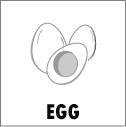“The definition of egg includes avian species’ shell eggs known to be commercially marketed in the United States. Also included are the eggs of quail and ratites such as ostrich. Not included are baluts.”
– FDA Food Code 2017 Annex 3 Public Health Reasons – Administrative Guidelines, Page 338

Hen’s Eggs – (-ova-)
Allergy to egg proteins usually presents around 1 year of age, reflecting the typical age of introduction of egg into a child’s diet.
- 2.5% American 3-year-olds are allergic.
- 2% remain allergic into adulthood.
- Is seen as a “lifelong” allergy.
Tolerance to egg is achieved with resolution in:
- 37% allergic children by age 10
- 68% allergic children by age 16
Relevance to Food Workers and Food Service
- Egg as part of a baked good is less allergenic than a whole egg or liquid egg product – careful cleanup is required during and after preparation.
- Watch the mayonnaise (it IS egg)!
- Awareness that egg can be a hidden ingredient in many foods.
- High-touch and common surfaces soiled with egg must be thoroughly cleaned as egg is a potent contact allergen.
Egg White
Albumen
Albumin
Avidin
Lysozyme
Mayonnaise
Ovalbumin
Ovoglycoprotein
Ovoglobulin
Ovomucin
Ovomucoid (heat-stable)
Ovotransferrin
Silica albuminate
Surimi
Egg Yolk
Apovitellin
Livetin
Mayonnaise
Ovovitelin
Ovovitellin
Surimi
Vitellin
Most-likely contains Egg
Binder
Cholesterol-free egg substitute
Dried egg solids
Dried eggs
Egg
Egg solids
Egg substitutes (some)
Egg wash
Egg white
Egg white solids
Egg yolk
Eggnog
Flavoproteins (flavin enzyme)
Glaze (on baked goods)
Globulin (protein)
Mayonnaise
Meringue
Meringue powder
Powdered egg
Sauces
Surimi
Hollandaise
Bearnaise
Florentine
Whole egg
“Balut” means an embryo inside a fertile EGG that has been incubated for a period sufficient for the embryo to reach a specific stage of development after which it is removed from incubation before hatching. – https://www.ecfr.gov/current/title-21/chapter-I/subchapter-B/part-160
Rules for Shell Eggs – https://www.ecfr.gov/current/title-21/chapter-I/subchapter-B/part-115
Eggs and their Derivatives
The dietary derivatives of egg white and yolk have several uses in food production.
Egg White Derivatives:
- Ovomucoid is used as a binder and emulsifier in various food products, such as meat and dairy products.
- Ovotransferrin is used as a source of iron and as a food preservative due to its antimicrobial properties.
- Ovalbumin is used as a source of protein in sports supplements, such as protein powder.
- Lysozyme is used as a food preservative to prevent spoilage caused by bacteria.
Egg Yolk Derivatives:
- Livetin is used as an emulsifier in processed foods to improve texture and stability.
- Phosvitin is used as a source of phosphorus and as a food emulsifier.
- Lipovitellin is used as a source of lipids (fats) in processed foods.
- Yolk immunoglobulin G (IgG) is used as a source of antibodies and as an ingredient in some functional food products.
Here are some other common dietary derivatives of egg proteins that may be used in food products:
Albumin: A protein found in egg white that is used in a variety of food products, such as baked goods, processed meats, and sauces.
Ovomucin: A protein found in egg white that is used as a thickener and emulsifier in some food products.
Conalbumin: A protein found in egg white that is used as a binder and emulsifier in some food products.
Globulin: A protein found in egg white that is used as a binder and emulsifier in some food products.
It is important to note that these egg protein derivatives may not always be listed specifically on ingredient labels. If you have an egg allergy, it is important to carefully read all ingredient labels and to be aware of the potential for cross-contamination in food processing and preparation environments. Additionally, it is recommended to speak with a healthcare provider or a registered dietitian for personalized guidance on how to manage an egg allergy.